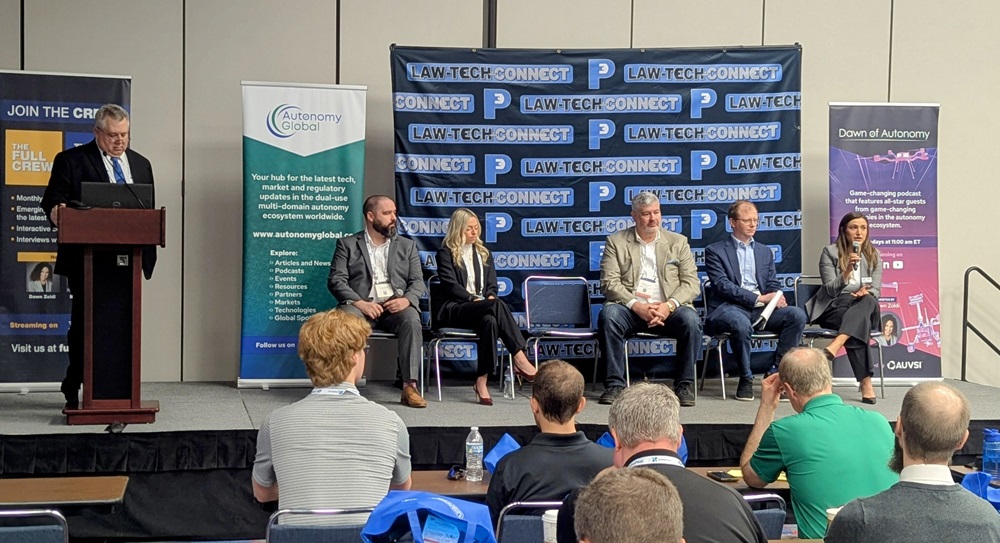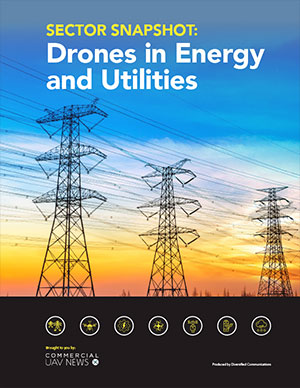Kicked off by Dawn Zoldi, the 4th annual Law-Tech Connect pulled together legal, technology, and policy experts to explore the latest happenings impacting the drone industry. Moderated by Michael K. Bauer from Engineering Systems Inc. (ESi), the Rules for Landing Government Autonomy Contracts panel opened the event that takes place each year on the eve of XPONENTIAL. The session detailed the successful approaches organizations are taking to securing these contracts while also highlighting larger shifts and happenings across the wider drone ecosystem.
While these shifts have been happening at every level of government over the past few years, the speed of these changes has been taken to another level in 2025, with teams and companies sometimes needing to make daily adjustments. These changes can be difficult to keep track of, but a larger commitment to the technology is there at the highest levels.
“We’re seeing increased funding from Congress, which shows the interest in advancing autonomous technologies,” said Lauren Regic from Carahsoft. “The initiatives around counter-UAS measures are also becoming an incredibly important aspect of our defense strategies.” Regic talked through the specific federal programs that are enabling procurement, as well as the various opportunities at the state, local, and tribal levels.
These opportunities are connected to programs like the Defense Innovation Unit’s Blue UAS Program, AUVSI’s Green UAS Program, SBIR/STTR, NASA SEWP, and OMNIA. Exactly what it means for different organizations to pursue any of them is something Casie Ocana from AUVSI helped to fully detail, which she connected to recent news for a new two-tiered system for Blue UAS.
“It opens the program up to so many other organizations,” Ocana said. “That’s part of the reason the Green UAS program was launched.” She explained how the Green UAS program was designed to make sense for the private sector, but the opportunities it helped to realize are now being further leveraged.
Those specifics highlight what need to be new and reimagined procurement strategies in light of initiatives being advanced by the Trump administration that are influencing wide swaths of the economy. Those initiatives and that influence are making a real impact on how contracts are being awarded.
“It’s never been more important to understand exactly how the government is spending these funds,” said Eric Ransom from Crowell & Moring LLP. He talked about the daily updates that his team makes to keep up with these changes, as well as trackers that allow stakeholders to better understand the context of what's changed.
When it comes to the advice and tips that the panel had for anyone looking to land a government contract, working with a distribution partner can be the difference between securing an agreement or not. The concept of working with a partner that can serve as a “contract vehicle” is something that Thomas Swoyer from GrandSKY UAS Flight Test Center talked through specifically, although he also provided practical advice.
“Constantly be scanning for available RFPs and RFI’s,” Swoyer said. “Sometimes people don’t get many bids, so they might want to talk to you. Also, don’t overthink it. If they ask for X-Y-Z, give them X-Y-Z. It’s not the time to provide feedback about what isn’t in or should be in their proposal. You also need someone who understands federal contracts and all the terms and questions that come with those contracts.”
These concepts force teams to be proactive and get in front of government stakeholders to better understand their needs, even before the official RFP. It’s something that Dan O’Shea from MatrixSpace talked through in detail.
“You want to find these bids and engage with the stakeholders,” said O’Shea. “Proactivity ensuring that we’re on top of the discussions is key. We also work with retired military officers, and they've been instrumental in the process, which allowed us to line everything up. Having resources like that at hand so you can quickly respond to questions from stakeholders can be a major difference.”
That practical advice was further detailed as being able to work with people who understand what it means to get ahead of cybersecurity issues and how to approach creating zero-trust architecture. Swoyer also mentioned the importance of video, as having video of what you’re doing can be a game-changer.
Their insights highlighted how there is no one single approach to successfully securing federal, state, local, tribal, and territorial government-level deals. Securing these sorts of contracts is much more about people and process than it is policy and technology.
















Comments